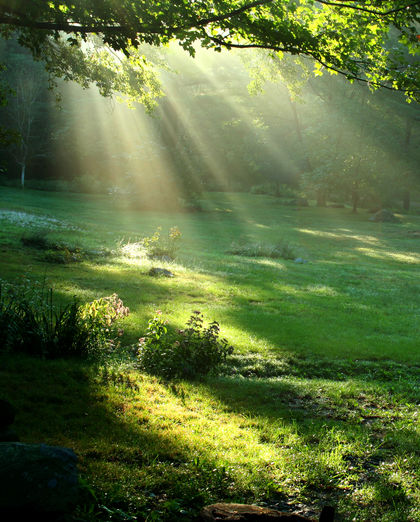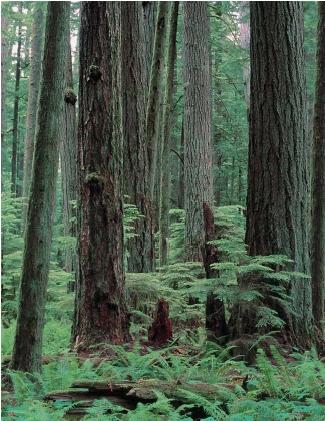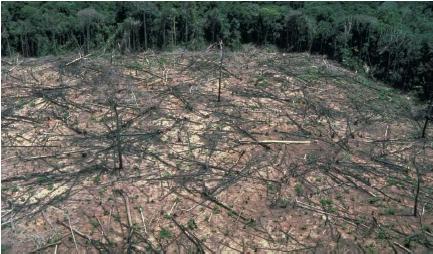Forests

A forest is an ecosystem or ecological community whose most important organisms are trees. Forests occur any place where the climate provides a sufficiently long growing season, adequate air and soil temperature, and suitable amount of moisture. Forests can be classified into broad types on the basis of their geographic position and dominant types of trees. Regional and local variations of all of these types can be found as well.
Types of forests
The designation of forest types varies from country to country throughout the world. One of the most widely used systems is the one proposed by the United Nations Educational, Scientific and Cultural Organization (UNESCO). This scheme lists 24 forest types, divided into two broad categories. One category includes forests with a canopy of at least 16 feet (5 meters) high and interlocking tree crowns. (The canopy is the forest's "covering," or the highest level of tree branches in the forest.) The second category consists of open woodlands with a relatively sparse, shorter canopy. Some example of the UNESCO categories with their general characteristics are described below.
Tropical rain forests. Tropical rain forests grow in regions of high rainfall and constant, warm temperatures. Because of these favorable conditions, tropical rain forests are extraordinarily biodiverse: these areas contain a wide variety of tree species and the largest concentration of plants, animals, insects, and microorganisms on the planet.
Words to Know
Biodiversity: The wide range of organisms—plants and animals—that exist within any given geographical region.
Boreal: Located in a northern region.
Canopy: The "covering" of a forest consisting of the highest level of tree branches in the forest.
Conifer: Plants whose seeds are stored in cones and that retain their leaves all year around.
Deciduous: Plants that lose their leaves at some season of the year, and then grow them back at another season.
Deforestation: The loss of forests as they are cut down to produce timber or to make land available for agriculture.
Ecosystem: An ecological community, including plants, animals, and microorganisms, considered together with their environment.
Old-growth forest: A mature forest, dominated by long-lived species but also including younger trees, with a complex physical structure that has multiple layers in the canopy, large trees, and many large dead standing trees and dead logs.
Temperate: Mild or moderate.
Tropical: Characteristic of a region or climate that is frost free with temperatures high enough to support—with adequate precipitation—plant growth year round.
Tropical and subtropical evergreen forests. Tropical and subtropical evergreen forests also contain a great diversity of biological species, but they are found in regions with a relatively limited rainfall. Some tree species are deciduous, meaning they lose their leaves at one point or another during the year. Still, enough species retain their leaves at any one time that the forest never becomes completely bare.
Mangrove forests. Mangrove forests are found in muddy coastal regions in the tropics and subtropics. Compared to the rain forests, mangrove forests have relatively few plant species. Those that do thrive are able to withstand exposure to salt.
Temperate deciduous forests. The trees in a temperate deciduous forest lose their leaves sometime during the year, only to grow them back again later. This type of forest occurs in regions that have moderately cold winters with a fair amount of rainfall.
Temperate winter-rain evergreen broadleaf forests. Temperate winter-rain evergreen broadleaf forests are not very common because the climatic conditions on which they depend are somewhat unusual. These types of forests thrive in areas with a definite wet season followed by a very dry summer, such as those in coastal regions of southern California.
Cold-deciduous forests. Cold-deciduous forests grow in regions with very cold winters. Typical tree species include aspen, birch, and larch.

Forests as habitats
Although trees are the largest, most productive organisms in forests, the forest ecosystem contains a great many other species of plants, along with numerous animals and microorganisms. Most of the species found in forests cannot live anywhere else. Often that need is very specific. For example, a bird species may require a particular type of tree species, tree age, and other conditions found only in a certain type of forest.

Old-growth Forests
Which is more important: a lumberman's job or the survival of the northern spotted owl? That question highlights one of the most dramatic ecological debates going on in the United States today. The debate centers on old-growth forests, which are ecosystems dominated by large, old trees, usually representing many species. The physical structure of old-growth forests is very complex, and includes multiple layers and gaps of foliage within the canopy, great variations of tree sizes, and many large, standing dead trees and dead logs lying on the forest floor.
Old-growth forests provide a habitat with very special ecological characteristics. These features are not present or as well developed in forests that are younger than old-growth forests. Some wildlife species require these specific qualities of old-growth habitats. As a result, they need extensive areas of old-growth forest as all or a major part of their range.
Some well-known, North American examples of species considered to be dependent on old-growth forests are birds such as the northern spotted owl, marbled murrelet, and red-cockaded woodpecker, and mammals such as marten and fisher. Some species of plants also may require or be much more abundant in old-growth forests than in younger, mature forests. Examples include Pacific yew and various species of lichens occurring in old-growth Douglas-fir forests of western North America.
The controversy over jobs versus owls arises because old-growth forests contain many very old, very large trees of highly desirable species. Lumber companies can realize very large economic profits from the cutting and removal of old-growth trees.
The destruction of old-growth forests presents two problems. In the first place, the loss of such forests destroys the habitats of many animals, such as the spotted owl and the marbled murrelet. Additionally, such forests are unlikely to be replaced. They develop over hundreds or thousands of years when left entirely untouched. In an age when humans are eager to harvest as much mature wood as possible, the chances of new old-growth forests developing are relatively small.
For example, Kirtland's warbler is a bird that nests only in stands of jack pine of a particular age and density in northern Michigan. This species does not breed in any other type of forest, including younger or older stands of jack pine. As jack pine forests have been cut down, the Kirtland's warbler has lost its natural habitat and is today listed as endangered. Similarly, the endangered spotted owl lives only in certain types of old-growth conifer forests in western North America. These same old-growth forests also sustain other species that cannot exist in younger stands, for example, certain species of lichens, mosses, and liverworts.
The previous examples are somewhat unusual. More commonly, animal species can survive in a more diverse habitat. In eastern North America, for example, white-tailed deer do well in a mixture of habitats, including relatively young stands that have abundant and nutritious food, along with mature forests, with some conifer-dominated areas that have shallower snow depths in winter.
More generally, forests provide the essential habitat for most of Earth's species of plants, animals, and microorganisms. This is especially true of tropical rain forests. Recent reductions of forest area are a critical environmental problem because they endanger or threaten animal and plant species and have an impact on climates around the world. The problem is especially difficult to deal with since most destruction of tropical rain forests has been performed in order to convert forest land to agricultural use.
Forests as a natural resource
Forests are extremely important because they provide a number of essential natural resources for human societies. The challenge is to find ways to harvest these resources while ensuring that they will continue to exist and be productive for generations in the future.
Wood is by far the most important product harvested from forests. That wood is commonly manufactured into paper, lumber, plywood, and other products. Moreover, in most of the forested regions of the less-developed world, firewood is the most important source of energy used for cooking and heating. Potentially, all of these forest products can be harvested without much danger to the ecosystem. Unfortunately, in most cases forests have been overharvested, resulting in the permanent loss of forest resources and widespread ecological damage.
Many other plant products also may be collected from forests. Some examples include fruits, nuts, mushrooms, and latex for manufacturing rubber. In addition, many species of animals are hunted in forests, for recreation or for food. Forests provide additional goods and services that are important to both human welfare and to the environment, including control of erosion and water flows and cleansing of air and water.
Deforestation
The term deforestation refers to the loss of forests as they are cut down to produce timber or to make land available for agriculture. In some cases, deforestation is a temporary condition as new trees grow back to replace those that are lost to the timber industry. In other cases, deforestation is a permanent condition, in which forests are lost forever.
The most common single cause of deforestation is human activities. Forest fires and attacks by insects also produce deforestation, although those produced by nature are generally only temporary conditions.
Some dramatic examples of deforestation are known from history. For example, forests mentioned in the Bible were long ago cut down to produce wood for human needs. Places such as the Forest of Hamath, the Wood of Ziph, and the Forest of Bethel are now deserts. Vast regions of the eastern and midwestern United States once covered by forests have become farmland or urban areas.
By some estimates, about 12 percent of Earth's forests have been destroyed since the beginning of human history. A large fraction of that loss has taken place in temperate and arctic regions. In recent decades, however, that pattern has changed. The forest cover in Western Europe and North America, for example, has become stable or has actually

increased. By contrast, the rates of deforestation in Latin America, Africa and Asia have increased at an alarming rate in recent decades.
This deforestation is driven by the rapid growth in size of the human population of these regions. As these populations grow, so do the needs to create more agricultural land to provide additional food and to harvest forests as fuel. In addition, large areas of tropical forest have been converted to agricultural use in order to grow crops for markets in wealthier countries, often at the environmental expense of local peoples.
The great threat of deforestation is, of course, the loss of a valuable renewable natural resource. In addition to the loss of economically important products, such as lumber, pulp for the manufacture of paper, and fuel wood to produce energy, essential animal habitats are destroyed. This habitat loss results in the decline of populations of both game animals and the great diversity of animals not hunted for sport or food. In addition, important ecological services that help maintain clean air and water and the control of erosion disappear as a result of deforestation also are stunted.
[ See also Biodiversity ; Endangered species ; Forestry ; Rain forest ; Slash-and-burn agriculture ; Tree ]
What are some different ways we use the forest?